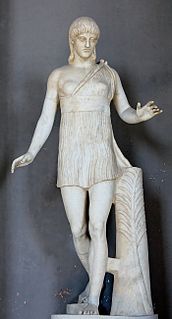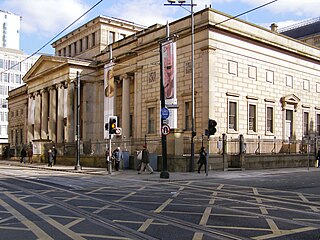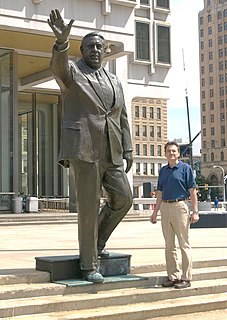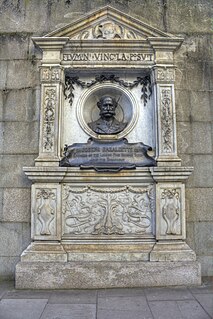|
Atalanta is a statue by English sculptor Francis Derwent Wood. It depicts a naked woman, standing in a contrapposto position, glancing to her left, with her left hand by her side and right hand raised to her shoulder. The subject is Atalanta, a virgin huntress from Greek mythology; she may be preparing for the foot race she used as an obstacle to prevent suitors securing a marriage.

Francis Derwent Wood was a British sculptor.

Contrapposto is an Italian term that means counterpoise. It is used in the visual arts to describe a human figure standing with most of its weight on one foot so that its shoulders and arms twist off-axis from the hips and legs in the axial plane. This gives the figure a more dynamic, or alternatively relaxed appearance. In the frontal plane this also results in opposite levels of shoulders and hips, for example: if the right hip is higher than the left; correspondingly the right shoulder will be lower than the left, and vice versa. The term can also be used to refer to multiple figures which are in counter-pose to one another. It can further encompass the tension as a figure changes from resting on a given leg to walking or running upon it. The leg that carries the weight of the body is known as the engaged leg, the relaxed leg is known as the free leg. Contrapposto is less emphasized than the more sinuous S Curve, and creates the illusion of past and future movement. A recent eye tracking study by showing that contrapposto acts as supernormal stimuli and increases perceived attractiveness has provided evidence and insight as to why, in artistic presentation, goddesses of beauty and love are often depicted in contrapposto pose.

Atalanta is a character in Greek mythology, a virgin huntress, unwilling to marry, and loved by the hero Meleager.
There are three main versions: a plaster version was exhibited at the Royal Academy in 1907; a 175 centimetres (69 in) high marble sculpture exhibited there in 1909 and presented to Manchester Art Gallery by the National Art Collections Fund in 1919; and a bronze casting which was erected by friends of the sculptor from Chelsea Arts Club at Chelsea Embankment Gardens, to the west side of Albert Bridge, in 1929, three years after Wood's death.

Manchester Art Gallery, formerly Manchester City Art Gallery, is a publicly owned art museum on Mosley Street in Manchester city centre. The main gallery premises were built for a learned society in 1823 and today its collection occupies three connected buildings, two of which were designed by Sir Charles Barry. Both Barry's buildings are listed. The building that links them was designed by Hopkins Architects following an architectural design competition managed by RIBA Competitions. It opened in 2002 following a major renovation and expansion project undertaken by the art gallery.

The Chelsea Arts Club is a private members club at 143 Old Church Street in Chelsea, London with a membership of over 3,800, including artists, sculptors, architects, writers, designers, actors, musicians, photographers, and filmmakers. The club was established on 21 March 1891, as a rival to the older Arts Club in Mayfair, on the instigation of the artist James Abbott McNeill Whistler, who had been a member of the older club.

Chelsea Embankment is part of the Thames Embankment, a road and walkway along the north bank of the River Thames in central London, England.
The bronze statue in London received a Grade II listing in 1969. The original casting was stolen in 1991 and replaced by a replica. Nearby is David Wynne's Boy with a Dolphin , and Edward Bainbridge Copnall 1971 statue of David, a copy of the sculpture by Wood atop the Machine Gun Corps Memorial.

A listed building, or listed structure, is one that has been placed on one of the four statutory lists maintained by Historic England in England, Historic Environment Scotland in Scotland, Cadw in Wales, and the Northern Ireland Environment Agency in Northern Ireland.
David Wynne was a British sculptor of figures, animals and portraits.

The Machine Gun Corps Memorial, also known as The Boy David, is a memorial to the casualties of the Machine Gun Corps in the First World War. It is located on the north side of the traffic island at Hyde Park Corner in London, near the Wellington Arch, an Equestrian statue of the Duke of Wellington, the Royal Artillery Memorial, the New Zealand War Memorial, and the Australian War Memorial.


















